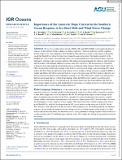Importance of the Antarctic Slope Current in the Southern Ocean response to ice sheet melt and wind stress change
Abstract
We use two coupled climate models, GFDL-CM4 and GFDL-ESM4, to investigate the physical response of the Southern Ocean to changes in surface wind stress, Antarctic meltwater, and the combined forcing of the two in a pre-industrial control simulation. The meltwater cools the ocean surface in all regions except the Weddell Sea, where the wind stress warms the near-surface layer. The limited sensitivity of the Weddell Sea surface layer to the meltwater is due to the spatial distribution of the meltwater fluxes, regional bathymetry, and large-scale circulation patterns. The meltwater forcing dominates the Antarctic shelf response and the models yield strikingly different responses along West Antarctica. The disagreement is attributable to the mean-state representation and meltwater-driven acceleration of the Antarctic Slope Current (ASC). In CM4, the meltwater is efficiently trapped on the shelf by a well resolved, strong, and accelerating ASC which isolates the West Antarctic shelf from warm offshore waters, leading to strong subsurface cooling. In ESM4, a weaker and diffuse ASC allows more meltwater to escape to the open ocean, the West Antarctic shelf does not become isolated, and instead strong subsurface warming occurs. The CM4 results suggest a possible negative feedback mechanism that acts to limit future melting, while the ESM4 results suggest a possible positive feedback mechanism that acts to accelerate melt. Our results demonstrate the strong influence the ASC has on governing changes along the shelf, highlighting the importance of coupling interactive ice sheet models to ocean models that can resolve these dynamical processes.
Citation
Beadling , R L , Krasting , J P , Griffies , S M , Hurlin , W J , Bronselaer , B , Russell , J L , MacGilchrist , G A , Tesdal , J -E & Winton , M 2022 , ' Importance of the Antarctic Slope Current in the Southern Ocean response to ice sheet melt and wind stress change ' , Journal of Geophysical Research: Oceans , vol. 127 , no. 5 , e2021JC017608 . https://doi.org/10.1029/2021JC017608
Publication
Journal of Geophysical Research: Oceans
Status
Peer reviewed
ISSN
2169-9275Type
Journal article
Description
This work was funded by NSF's Southern Ocean Carbon and Climate Observations and Modeling (SOCCOM) Project under NSF Award PLR-1425989, with additional support from NOAA and NASA. Logistical support for SOCCOM in the Antarctic was provided by the U.S. NSF through the U.S. Antarctic Program. This work was also supported by the U.S. DOE Subcontract no. B640108 under Prime Contract no. DE-AC52-07NA27344. RLB was additionally supported by the NOAA Climate and Global Change Postdoctoral Fellowship Award. Computational resources for the SOSE were provided by NSF XSEDE resource grant OCE130007.Collections
Items in the St Andrews Research Repository are protected by copyright, with all rights reserved, unless otherwise indicated.

